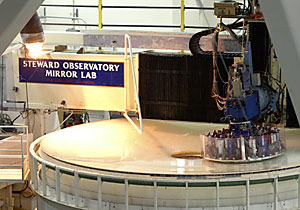 |
|
KEVIN B. KLAUS/Arizona Daily Wildcat
|
An 8.5-meter mirror is polished yesterday afternoon at the Mirror Lab under the football stadium. The mirror will be used in a Large Synoptic Survey Telescope used to scan the atmosphere for asteroids.
|
|
|
By J. Ferguson
Arizona Daily Wildcat
Friday, January 21, 2005
Print this
A contract with the UA's Steward Observatory Mirror Lab will help astronomers scan the sky for substantial asteroids possibly headed on a collision course with Earth.
A $2.3 million contract with the mirror lab will pay for the 8.4-meter diameter main mirror for the Large Synoptic Survey Telescope.
Philip Pinto, a UA associate professor of astronomy and member of the LSST board of directors, said the LSST is unique when compared to other telescopes because it uses wide-angle format rather than the traditional format used in telescopes.
Pinto said while other large telescopes look deep into the sky to observe the remote portions of the galaxy, the LSST will be surveying the visible sky every three days for objects much closer to Earth.
The ability to scan the whole sky every three days allows astronomers to make "mini-movies" of the sky, which is a radical departure from previous mapping efforts where very little attention was paid to the time aspect of astronomy, Pinto said.
"We will be able to scan the whole sky and then see what has changed and what has moved," Pinto said.
Pinto said by observing near-earth objects with the LSST, such as asteroids approaching Earth, astronomers will be able to accurately measure the paths of oncoming objects.
"There is a class of asteroids, 250 meters across, that would make a tsunami like the one (that) occurred in Indonesia, if they hit the Earth," Pinto said.
Donald Sweeney, the project manager for the LSST, said the time element for the survey telescope is very important.
Sweeney said other telescopes are insufficient for surveying the sky because they cannot be used to measure a certain region of space over a period of time, which hinders the ability to measure how the universe is expanding.
The ability to map the visible sky with the LSST may help scientists unlock the mysteries of dark matter and dark energy, which are critical components that could explain how the universe was formed, Sweeney said.
Dark matter is a form of matter found in space that cannot be seen by traditional telescopes, which record data by light waves or radiation. Evidence of the existence of dark matter is found from its gravitational effects on other visible matter, such as stars.
Dark energy is a theoretical form of energy that is thought to have negative pressure, which produces a repulsive gravitational force.
By making an extensive map of the visible sky, Sweeney said breakthroughs in dark matter and dark energy research is possible.
"The Department of Energy is very interested in dark matter (and) dark energy," Sweeney said.
Pinto said the LSST will be able to see objects that are 100-times fainter in the sky than the Keck telescope currently being used in Hawaii, which is vital for developing a "large dark matter map."
The contract was funded by the LSST Corporation; a group comprised of the National Science Foundation, the National Academy of Sciences and several national observatories.
Pinto said an enormous private donation from Arizona businessman Richard Caris helped jump- start the project. The $2.3 million contract is the first leg of an estimated $13.8 million effort to design, cast, polish and integrate the mirror into the LSST.
Sweeney said the goal was to have the LSST scanning the skies in 2012.
